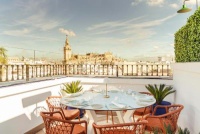The Arenal district, Seville
Tucked in between Avenida de la Constitucion and the river, El Arenal was home to the city's port, from where ships sailed to the New World - hence its name, from arena (sand), on the then-tidal river banks. These days, it's a well-heeled barrio with abacerias (shops selling conservas, tins and jars of food, and cheese), freidurias (fried fish takeways) and, as well as some good bars and restaurants.
El Arenal's main attractions are the bullring, the Moorish Torre del Oro, and the modern Maestranza theatre, as well as the Hospital de Caridad with its macabre paintings. The Reales Atarazanas, 14th-century Royal Shipyards, are being converted into a cultural centre, and there are plans to build a visitors' centre on the riverside walkway next to Almohad tower, which now houses a naval museum.The Plaza de Toros de la Maestranza (bullring), one of the most famous in the world, was featured in Carmen, whose bronze statue stands opposite the building.
El Arenal's history is closely linked with Seville's rich naval and military past, as shiploads of merchants, adventurers and sailors set off from the port to make their fortune in the Americas in the 16th century. In those days it was a bustling, prosperous area, with stores, shipyards and all the vices associated with sailors in those times. Arenal declined in the 17th century when the river silted up with sand, the area's naval importance decreased.
The area was regenerated when the river was cleared for Expo 92 and is now a smart area with upmarket horseriding and leathergoods shops, many bars and restaurants of all types, and, of course, great views over to Triana.
There is a new centre exploring Magellan's voyage, the first circumnavigation of the world, on the Muelle Marques de Contadero, near the Torre del Oro. It was opened as part of the 500th anniversary of this world-changing expedition in 1519-1522.
But its atmosphere is dictated by the bullring; during the season, April to September, it is packed with fight-goers predicting, arguing, analyzing and discussing the day's corridai> (bullfight) over a tapa and a caña (small glass of beer). Calle Arfe is a lovely street with bars and delicatessens, with a very local feel to it; check out bar Arenal.
In terms of art, the Hospital de la Caridad is one of the highlights of Seville. The baroque building was originally designed as a final resting place for those sentenced to death or drowned in the river. Thanks to the generosity of a rich Don Juan-like patron who saw the error of his debauched ways, it became a charity hospital for the sick and destitute of Seville today it's still used as a residencia de ancianos (nursing home). Its chapel has a famous series of paintings by Valdés Leal and Murillo about the good of charitable virtues and the evil of worldly wealth and pride; Murillo also painted the azulejos (ceramic tiles) on the chapel's exterior. Valdés Leal's celebrated but very gory Finis Gloriae Mundi shows a dead bishop and knight being fed upon by worms, while Murillo's paintings depict the more positive side of things: saints caring for the afflicated, Jesus feeding the multitude. The hospital has two delightful patios with fountains, decorated with 17th-century tiles representing the New and Old Testaments.
There are interesting prints of Sevilla in the late 16th century, with Arenal in its original sandy state (arena means sand) in the museum now housed in the Torre de Oro.
